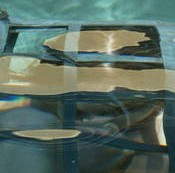December 31, 2004
December 29, 2004
December 10, 2004
Including Complexity
What is a jewel if not a concentric and focusing point or object . . . that which focuses the real?
Complexity exists; simply and obviously.
Recently, it would seem that it has become some sort of virture to express the complexity of modern life. Many streams of our cultural production are bent upon increasing the complexity of their products. Indeed, much work seems to add complexity to our experience as a means to express its pre-existing and central characterization of our current lives. However, we can be overwhelmed as natural complexity is mismanaged and the world becomes increasingly dominated by variants of noise: speed, contradiction, competition and insistence vis a vis our attention.
We can be overwhelmed and often are.
We cannot ignore complexity. There is always a need to deal with it. But how? Much 20th century art has worked to express or re-present our overwhelming sense of complexity. Restricted within the scope of aesthetic presentation, the whirl of modern urban life is placed before the viewer for comment. Some architects have likewise tried to express a wordly level of complexity in their designs; making into material expressively fractured and confusing compositions. To do so is a grave limitation of their art. after all, the success of such work depends upon a severe limitation or compromise of the fullness of the architectural aggenda.
The working of such buildings (working far beyond mere utility, if such terms can even be said) is sublimated to their expressive quality . . . an expressiveness which relies on a sculpturally reduced use of elements. It is impossible for buildings which are vehicles for the abstract expression of general themes of complexity to be focused on the expressive organization of the complexities already inhertent in their own context. That context is constituted by the miriad of conditions (site, material, use, etc.) from which need and desire have caused them to be financed and built in the first place. The mimicry of complexity and contradiction comes from an extra-architectural aggenda. While there is no need to create complexity for the sake of illustrating its existence in our lives, there is a need to give form to the complexity which already exists – program, urban issues, structure, circulation, the interrelationships of the inside-outside interface. Architecture needs to marshall the complexity that exists to express some form of “world.”
Architecture could be a means by which we focus complexity within the real.
The pre-existing complexities of a place can be exposed or concentrated in points of revealing which, like jewels, focus and structure the inclusion of that complexity in a project. This inclusion need not be of the complexity itself but rather of the idea of its expereience or presence within the work. The inclusion is an act of artifice. Complexity then takes on a figural presence. Instead of masking the complexity which naturally exists within an object, it is given places in which it can effect the experience of that object without undue domination . . . without overwhelming the subject of that experience. In other words, it needs to be to be set into an accord with the singular and simple (indeed, with the empty), such that together they compose a sensible set of figure-to-context relationships. The nature of these relationships find governance through need and desire. This does not mean that the root of all is purely subjective. The subject is only the vehicle in which the object (in line with infinity) is filtered in meaningful (finite) ways.
December 06, 2004
poem 010
We be,
bleached bone,
all centre caged,
wind blown,
and burned it be,
our first,
as we see,
all awkwardness,
shared by an account,
forclosed, so small,
it was drawn,
long past reason,
....reasoning on,
through salt,
dried skin,
covered bone,
left slowly in retreat,
as a savings,
withdrawn,
we give,
....we be,
like lead on paper
scribed,
drawn idle and still,
before giving lastly away.
December 01, 2004
¤
a bit from Gunslinger, [1]
. . .
Nor could, my child, that which exists
be more Here and less There
The thing that can be thot
and that for the sake of which
the thot exists
is the same as the only function
and in it the Power of Reality rides
behind the oneway vision of the darkened glass
snowblind with fixity, on the Equator
. . .
[1] Edward Dorn, Gunslinger (Durham, N.C.: Duke University Press, 1989): 174.






